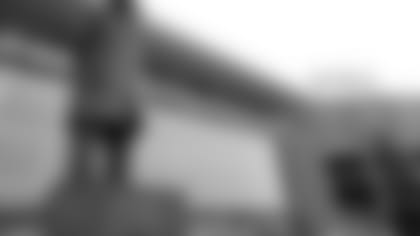For all they represent about the past, the larger-than-life bronze statues of Curly Lambeau and Vince Lombardi that welcome fans to the stadium's main entrance have taken on additional meaning now that the Packers have added to their annals a 13th league title.
"There are 11 world championships there, you know?" said former Packers President/CEO Bob Harlan, whose idea it was to include the statues in the Lambeau Field redevelopment project, which was completed in 2003. "I just thought they gave impact to the stadium. I think they add warmth, because there's so much tradition."
A fan of that type of artwork, Harlan had wanted to erect statues outside the stadium celebrating some of the team's history for quite some time, but there wasn't a suitable location.
Once the redevelopment plans were underway, Harlan seized the opportunity. Appropriately, the plaza in front of the Lambeau Field Atrium where the figures are located is named for Harlan, with a representative plaque between the statues.
As for any instructions to the artists who were commissioned to sculpt Lambeau and Lombardi, Harlan kept it pretty simple.
"The first time I talked to them, I told them where they were going to go, and I said, 'I want you to understand these are going to be in front of a huge glass background in front of the stadium,'" Harlan said. "So I said, 'Please make them as large as you possibly can. I want them big and imposing so they jump out at you when you come by the stadium.'"
Their sheer size – 14 feet high on top of 6-foot bases – is what made the project particularly unique for Omri Amrany and Julie Rotblatt-Amrany, the husband-wife team that emerged from a group of six competitors to earn the commission for the two statues, which cost around $100,000 apiece.
Omri Amrany worked primarily on Lambeau, while his wife took on Lombardi.
"Architecturally, they're real strong pillars to the entrance, because they're so large and they bring you into this huge façade of Lambeau Field," Rotblatt-Amrany said. "Metaphorically, it's who they were in Packers history."
Paradoxically, the 14-foot statues began as 18-inch models in the initial stage of the nine-month construction process.
Rotblatt-Amrany said that often times with such large-scale projects, artists will blow up a special foam into an oversized framework and then sculpt the details with an outer skin of clay.
For these pieces, however, she and her husband built them using wood, welding rods, and clay, what she called "the old-school way." Both Packers icons surely would have been proud to hear that.
Harlan had given the couple one Lambeau photo, of him holding a football and pointing, which depicted exactly what he envisioned. For Lombardi, a collection of photos were melded into the final image, which included the camel-hair coat, the hands-behind-the-back posture, plus the fedora and somewhat sideways smirk from the cover of David Maraniss' biography of Lombardi, When Pride Still Mattered.
Rotblatt-Amrany said a family friend loaned her a camel-hair coat to work from, which helped in sculpting one around a 14-foot body. Her husband noted that Lombardi's fedora scraped the ceiling of their studio when the statue was fully upright.
For both pieces, the artists removed the heads and lowered them to a table so they could put the requisite effort into the facial subtleties without working from such dangerous heights.
"If you don't catch the personality, what do you get?" asked Omri Amrany. "Just a bronze piece."
From molds, they made fiberglass copies of those heads, as well as Lombardi's behind-the-back hands, for their "mementos" from the project. They're on display in the Rotblatt-Amrany Fine Art Studio just north of Chicago in the suburb of Highland, Ill.
Visitors to the studio are immediately drawn to those pieces, just like stadium patrons are to the statues themselves. Seeing the heads alone and up close, fans are struck by the eyes of the men. Coincidentally or not, last year's HBO movie on Lombardi's life closes with a shot of the full statue and then close-ups of Lombardi's head and hands.
"There's no doubt it's very emotional for people," Omri Amrany said. "Whoever comes here, when they go into the room, it's the first thing: 'Hey, look.' It doesn't matter who the fans are."
For a couple that has produced an impressive list of commissioned sports pieces – the Michael Jordan sculpture outside the United Center in Chicago (1994), the tribute wall to George S. Halas at Soldier Field (2004), the blurred-action Gordie Howe at Joe Louis Arena in Detroit (2007), and the memorial to Pat Tillman outside University of Phoenix Stadium (2007), among many others – the two artists said it would be too difficult to rank the Lambeau and Lombardi statues among their accomplishments, but it isn't hard to explain their personal significance.
"For us, the Green Bay Packer project was a very important milestone," Omri Amrany said. "If we wouldn't get the Packers, we maybe would not get the Bears, or we maybe would not later on get Pat Tillman."
In the hands of other artists, Lambeau Field's entrance may not have turned out so captivating, either.
"I told our executive committee when we were doing it, I said, 'This is going to be the most photographed area in the state of Wisconsin,'" Harlan said. "I truly believe it is. They captured the two men."
Mike Spofford is a 1995 Masters graduate of the Medill School of Journalism at Northwestern University who worked as a sports reporter for two daily newspapers in Wisconsin, covering the Packers in Super Bowl XXXII. Spofford has been a packers.com staff writer since 2006.















